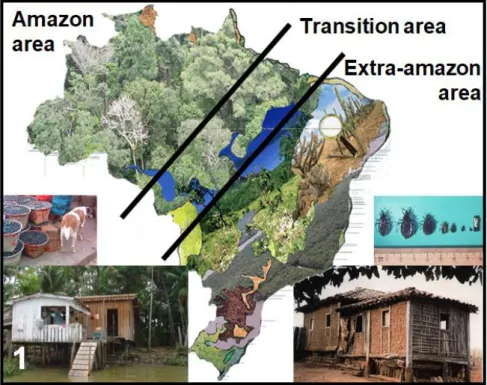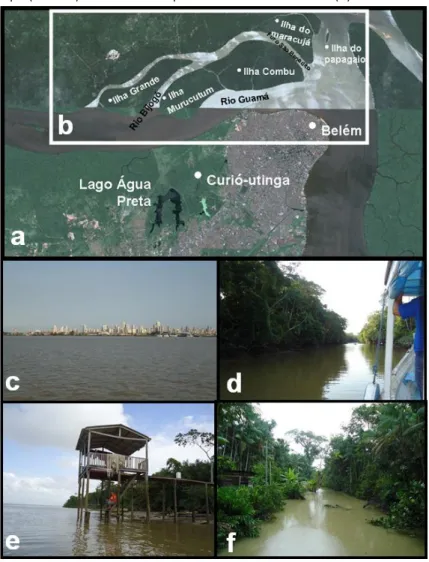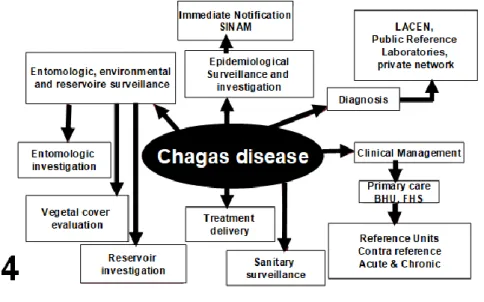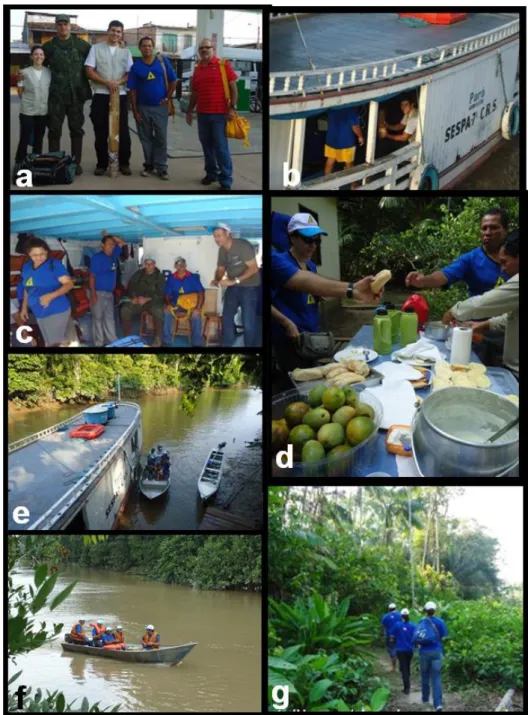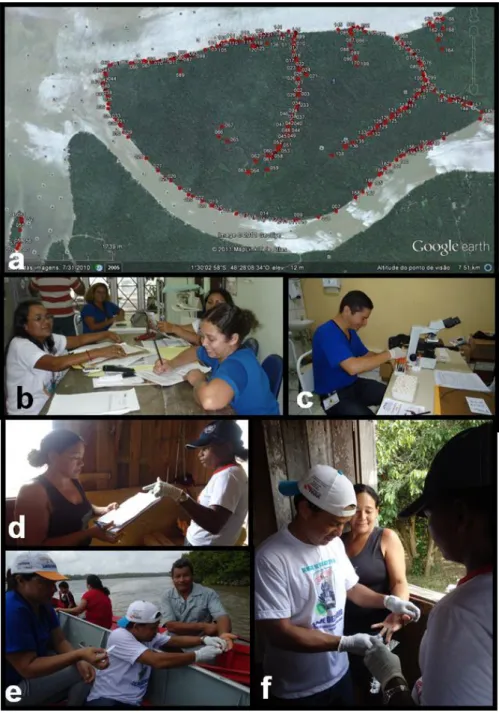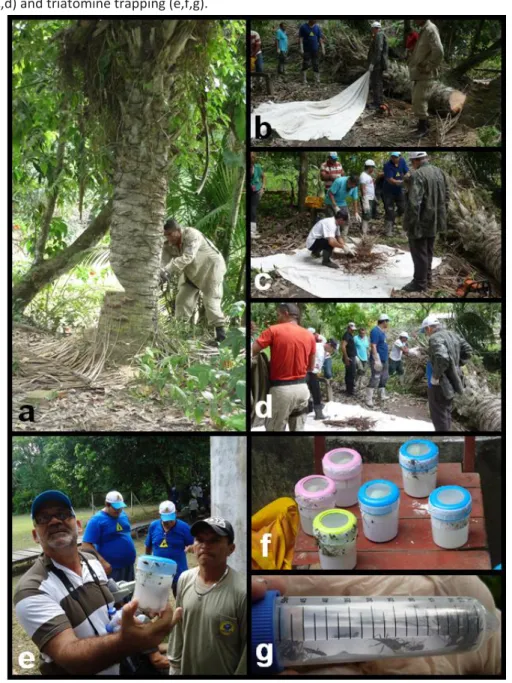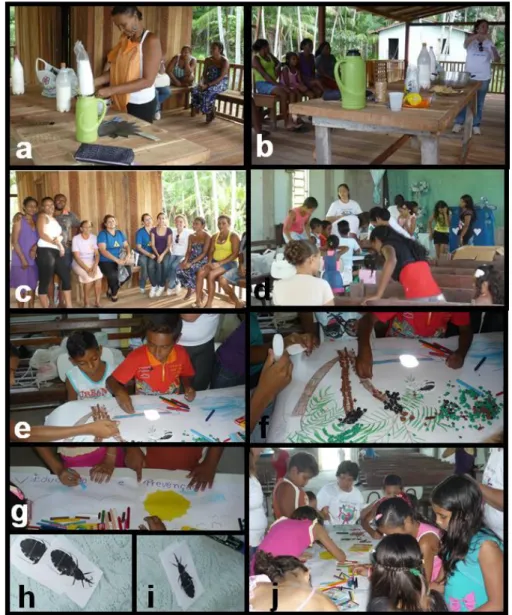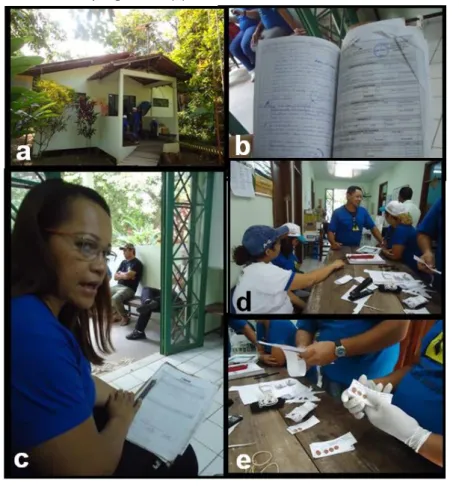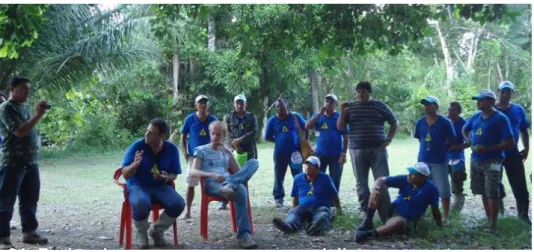Página | 321
https://periodicos.utfpr.edu.br/rbect
Interdisciplinary network engagement in a
non-formal education process to study
foodborne Chagas disease puzzle in
Brazilian Amazon
ABSTRACT Tania Cremonini de Araújo-Jorge
taniaaj@ioc.fiocruz.br 0000-0002-8233-5845
Lab. de Inovações em Terapias, Ensino e Bioprodutos-LITEB, Inst. Oswaldo Cruz, Fund Oswaldo Cruz-Fiocruz, Rio de Janeiro - RJ - Brasil. Médica, Doutora em Ciências, Pesquisadora Titular em Saúde Pública, docente e coordenadora do Programa de Pós-Graduação em Ensino em Biociências e Saúde-Fiocruz.
Cristina Xavier Almeida Borges
cristina.borges@ioc.fiocruz.br 0000-0002-1120-9518
Lab. de Inovações em Terapias, Ensino e Bioprodutos-LITEB, Instituto Oswaldo Cruz, Fiocruz, Rio de Janeiro, Cientista Social, Doutora em Medicina Tropical. Pós-Doutoranda do PPG em Ensino em Biociências e Saúde-Fiocruz. Alciana Araújo
alcianaaraujo@gmail.com 0000-0002-4466-2597
Secretaria de Saúde do Pará, Belém, PA; Brasil. Social scientist, teacher
Soraya Oliveira dos Santos
sorayasantos@hotmail.com 0000-0002-1606-2543
Secretaria de Saúde do Pará, Belém, PA; Brasil. Médica Veterinária, Doutora em Ciências Biológicas, Consultora da Fiocruz para apoiar a construção da Sala de Situação da Secretaria de Saúde do Distrito Federal.
Elenild de Góes Costa
elenild@gmail.com 0000-0003-1449-3734
Secretaria de Saúde do Pará, Belém, PA; Brasil. Farmacêutica, Doutora em Ciências, Divisão de Controle de Qualidade de Alimentos/Vigilância Sanitária/SESPA
Interdisciplinary collaboration is essential to overcome complex problems in contemporaneity. Chagas disease challenges in Brazilian Amazon, implicates One Health interdisciplinary approaches and teams to integrate health of humans, animals and the environment, to foster earlier detection of this zoonotic disease and better prevention. We studied the interdisciplinary team, the logistic of its long term field work and the education processes emerging on a non-formal education environment of a Chagas disease Protocol conduced in Pará. An alarming situation: notified acute cases almost doubled in two years. Photographs were presented (iconographic approach) to qualitatively describe the experience of the interdisciplinary team. Five recommendations were proposed at the end of the study. Our observational study with the interdisciplinary team confirmed the conception that “in connecting the purity of science with the pragmatism of policy, the intangibles of trust, rapport, and even friendship can be more potent than logic and more compelling than evidence”.
PALAVRAS-CHAVE: Health education. Neglected disease. Interdisciplinarity. Amazon.
Página | 322
INTRODUCTION
Interdisciplinary collaboration is essential to overcome complex problems in contemporaneity (KAHN; PRAGER, 1994). Health challenges are among those needing intensive interdisciplinary approaches and collaborations, both for basic and operational research as well as for education of teams directly evolved and of people potentially affected. The One Health concept (HINCHLIFFE, 2015) emerged in the last two decades, as the structured collaboration and coordination between human, animal and ecohealth systems, and implicates interdisciplinary teams as a central issue. Chagas disease global challenges (WHO, 2016), and especially the challenges in Brazilian Amazon, implicates One Health interdisciplinary approaches and teams to integrate the health of humans, animals and the environment, to foster earlier detection of this zoonotic disease and better prevention (LANNES-VIEIRA et al., 2010, COSTA et al. 2017).
Almost 2000 acute cases of Chagas disease were recorded in the last decade in Brazil, mostly Amazon. The state of Pará was responsible for about 66% of the cases (XAVIER et al, 2014) in Brazil and for more than 92% of cases in the northern region of the country, with a mortality rate of 6.2% between 2010 and 2011. This emergence is a complex and new phenomenon not yet completely understood (AGUILAR et al. 2007; PINTO et al, 2013; SANTOS et al, 2018). It implicates the organization of interdisciplinary teams of researchers and health professionals besides clear and well-designed leadership. The high number of cases in Amazon contrasted with the serological picture displayed by the national serological survey in children under 5 years (LUQUETTI et al. 2011) and is an important subject in national and in local media. This emergence led the State Health Administration (SESPA) to organize and implement a “Protocol for definition of T. cruzi transmission risk areas” (SANTOS, 2013). Our group has participated in this joint effort to understand the complexity of Chagas disease transmission and control in Amazon. In this paper our goal was to describe the interdisciplinary team, the logistic of a long term health field work and the education processes emerging on this non-formal education environment.
The complex scenario of Chagas disease in Brazil: a challenge for information and education
In 2006 Brazil received from Pan American Health Organization (PAHO) the certificate of elimination of Chagas disease through Triatoma infestans transmission (MASSAD 2008). This success reflected the sustainable fall in incidence of the disease in children between 7 and 14 years, the fall in house infestation and a slow but sustainable fall in mortality rates in chronic patients. New facts since then were: (a) a Brazilian serological survey of children under 5 years, performed in more than 2,000 municipalities, showed the high advance and success in T. infestans control (LUQUETTI et al. 2011); (b) vector transmission decreased due to an accelerated urbanization (TORRES NETO; TORRES; ALMEIDA, 2014) and social and economic improvement (FREITAS; GIATTI, 2009); (c) prevalence of Chagas disease increased in persons from 60-80 years old with concomitant co-morbidities typical of elderly (MATOS et al. 2014). But two new phenomena dominate Chagas disease scenario in Brazil: (d) high number of new acute cases reported in Amazon, with Trypanosoma cruzi transmission mainly by
Página | 323
foodborne contamination and oral route (PEREIRA et al. 2009), as well as by conventional vector transmission (AGUILAR et al. 2007), and (e) by a new “distantiae transmission” model recently described (XAVIER et al 2014). Mortality curve by Chagas disease in Brazil almost stabilized (MARTINS-MELO et al. 2012), but showed important regional differences, with a crescent trend in the Northeast and in the North regions of Brazil.
Both transmission and mortality are strongly influenced by poverty and inequality and there is unequal distribution of deaths, as well as possible differences in age structures of populations in regions of Brazil (MARTINS-MELO et al. 2012). A recent systematic review and meta-analysis on 42 studies calculated a total prevalence for the last three decades and suggested that estimations for Brazilian population should be revised: there are probably more than the 4 million infected chronic cases (MARTINS-MELO et al 2014). This study provided further evidence for the need for introduction of chronic forms as a notifiable disease, a challenge that deserves a national public policy.
A very strong and new aspect in Chagas disease scenario is the emergence of patients and affected people, families and health personal, both in local and international associations to fight for the access to treatment, care and knowledge about their health conditions (CHATELAIN, 2014). This new social movement, bringing their voices to society and to academy, is the most important fact in the last years concerning the fight for Chagas disease solutions.
Health education, science education and interdisciplinarity
Since the historical review of Lavin et al (2001) showing that interdisciplinary health professional education, practice, and research is a global movement, many studies approach inter, multi and transdisciplinarity in health education, as well as in science and in general education. To cross subject boundaries always facilitate a better learning experience for those engaged in that specific development. Innovation in education is a natural consequence of those processes (BAUERLE; HATFULL; HANAUER, 2014). But it is important to disclose the differences between “multidisciplinarity” and “interdisciplinarity” BROGGY et al. 2017). In a multidisciplinary approach, different subjects contribute independently to a theme under investigation, maintaining a separate identity. In an interdisciplinary approach, “common learning and concepts are identified across multiple subjects to address a theme. In this case subjects overlap with each other and the theme and are truly integrated, employing interdisciplinary skills such as literacy, numeracy and research and seeking to understand how the subjects speak to each other and the theme” (BROGGY et al., 2017).
METHODS
Document analysis and information databases: to paint the most actual
picture of Chagas disease in Pará a search was performed in academic literature on bibliographic bases (Scopus, PubMed, Scielo) associating these keywords. Governmental directions and operative recommendations were also consulted. In Brazil, only new acute cases are compulsorily notified and we searched for all cases that were notified in Brazil between 2007 and 2016, the decade just after PAHO
Página | 324
certification of T. infestans interruption of Chagas disease transmission in Brazil (MASSAD 2008). Data were obtained from the Notifiable Diseases Information System of Brazil Health Ministry (SINAN - Sistema Nacional de Agravos Notificáveis)
freely accessible at
http://tabnet.datasus.gov.br/cgi/tabcgi.exe?sinannet/cnv/chagasbr.def.
Geographic Area and protocol general design: The work was conducted at
Combu island, Belém, capital of the Pará state, in northern Brazil. Of the cases reported in Pará 39.5% occurred in Belém or in its neighborhoods (XAVIER et al. 2014, COSTA 2017). The Combu expedition was conducted successively for 15 days, between November 5 and 19th 2011, to study the risks of T. cruzi transmission in the island, in a large socioeconomic and serological survey of families and their domestic dogs and cats, as an integrated action with the Control Programs for Leishmaniosis and Rabies (COSTA, 2017). An entomologic survey was also performed in intra, peri and extra domicile areas.
Subjects, ethics, interviews and qualitative analysis: For this study, during 4
days in the middle of the 15 days Combu expedition, we photographed all the actions of the work and interviewed the persons coordinating the interdisciplinary team. After explanation of the research goals they gave their voluntary consents for audio recording and photo registering the interviews. Three main questions were asked: 1- What do you do in the team? 2- What is your main motivation? 3- Do you want to say anything else that we did not ask? Audio records were further transcribed literally for qualitative discourse study using traditional methods of content analysis (MINAYO, 2004). The visual ethnographic method was used (SCHWARTZ, 1989), complemented by participant observation practices (TEDLOCK, 1991).
RESULTS AND DISCUSSION
Chagas disease in Pará and the Combu island region
With the aim of analyzing peculiarities related to the operational activities of Chagas disease control it is possible to divide Brazil in two different “countries”: the extra-Amazon and the Amazon areas, with a transition in between (Fig. 1). In the extra-Amazon area, vector transmission predominates, triatomine colonize houses and peridomicile (Fig. 1, right), and health care system is able to at least partially detect and help chronic people. Here the control strategy focus on domiciliate triatomine active search and house improvement. In contrast, in the Amazon area there is no adult insect colonization of the houses, both oral and vector mechanisms of transmission overlay (Fig. 1 left), and the health system is not well prepared to see and to deal with the patients (NÓBREGA et al, 2009). Here the main focus is the detection of human cases to provide timely treatment of acute and indeterminate cases, specially using the strategy of diagnosing T. cruzi in microscopy blood smears collected for malaria control (DIAS; PRATA; SCHOFIELD, 2002). Additionally, in Pará and other Amazon states, new agricultural fronts, construction of dams and highways, large monoculture areas (e.g. açaí fruit), timber extraction and mining activities, all actions related to economic development of the region, contributes to alter forest fauna, to reduce biodiversity, to attract triatomines and reservoirs and to increase the risk factors
Página | 325
for Chagas disease (ARAUJO et al, 2009, ROQUE et al, 2013). In the transition area, represented by the states of Tocantins, Maranhão and Mato Grosso, both biomas are found and the control strategy needs to be adapted according to the particularity of each micro region.
Figure 1: Current status of Chagas disease in Brazil by considering contrasting transmission characteristics observed in the Amazon and the extra-Amazon areas. The figure including images of different types of houses and elements related to Trypanosoma cruzi foodborne transmission associated with fruits harvest and manipulation in the left (Amazon area) and to vector transmission in the right (extra-Amazon area). General scheme prepared by authors EGC and SOS.
(Source:the authors)
Figure 2: Number of cases of acute Chagas disease in the different geographical regions of Brazil recorded in the National Information System of Notifiable Diseases (SINAN) of the Health Ministry from 2007 to 2016.
Página | 326
During the socio epidemiological survey, we found many island inhabitants that displayed misconceptions about triatomine risk in the area. They knew from the media and from school books that the “risky” house was that of adobe (Fig. 1 right) and considered their wood riverside houses as “safe”. However, they did not know that the main vector in this region were not domiciliated, but lived in the palms and in the peridomicile, thus extending the risk to the ground area.
Acute Chagas disease is compulsory notified to the Health Ministry since 2001. After some oral outbreaks related to sugarcane contamination ( ), notifications increased. The complexity of Chagas disease picture in Brazil now was stressed in 2007 when a public health alert sorted out from sanitary surveillance system, indicating the danger of oral infections (BRASIL, 2007). The first description of an autochthonous case in Belém was performed four decades ago (SHAW et al. 1969), but more than a thousand new acute cases were notified from 2000 to 2010, 70% of them occurring by oral transmission, 5% by vector transmission and the remaining 25% with by unknown mechanisms (NÓBREGA et al. 2009). We searched for the number of cases notified on SINAN from 2007-2016, verifying that cases are still happening in all regions and confirmed the extremely high problem in the North region with an alarming increase after 2014 (Fig. 2, Table).
Table: Recorded cases of acute Chagas disease in Brazil (SINAN)
Year Country Region Brazil
N NE CW S SE 2007 151 3 1 0 0 155 2008 96 8 0 0 0 104 2009 214 5 1 0 0 220 2010 104 10 15 1 0 130 2011 166 16 8 0 0 190 2012 186 0 0 1 2 189 2013 157 2 1 1 2 163 2014 192 1 1 1 1 196 2015 259 9 0 0 0 258 2016 363 11 0 0 0 374 Total 1888 65 27 4 5 1979 % 95,4 3,3 1,4 0,2 0,3 100,0 (http://tabnet.datasus.gov.br/cgi/tabcgi.exe?sinannet/cnv/chagasbr.def) data collected and revised May 10th 2018
The number of acute cases confirmed by an etiological diagnosis was relatively stable between 2007 and 2013, varying between 100 and 200 cases (Fig. 2). However, the tendency to increase towards 300 and 400 new cases/year (Fig. 2, Table 1) clearly show that the control protocol that was setup previously had failed. An integrated action by health services in the states of the North region is urgently needed to understand the problem and to try to control and solve it with the
Página | 327
available prevention tools and strategies. Health surveillance needs to be set up again in the region.
Combu is a 15 km2 sparsely occupied island (1,500 people) situated on the left bank of the river Guamá (Fig. 3 a, b), at about 1.5 km south and in front of the urban area of Belém (Fig. 3c), the second most important economic center of the Brazilian Amazon region. The island (Fig. 3 d, e) stills within the cities´ political limits, is the largest açaí producer, has a public health service infrastructure and lies in an environmentally protected area (Law 6083, Nov 13rd 1997). Vegetation cover is typically Amazonian forest (Fig. 3f), with restricted exploration where fruit collection (mainly açaí) occurs in addition to subsistence plantation. The region and the sylvatic cycle elements of Chagas disease transmission was more deeply showed in the work of Xavier et al. (2014), describing a new epidemiological feature of Chagas disease named as ‘‘Distantiae transmission’’. This indicate that new cases of infection in the urban area of Belém may be derived from infected sylvatic triatomine bugs coming together and accidentally transported with the açaí fruits from the islands that provide the fruit bulk sold in the metropolitan area.
The unique interdisciplinary experience of Pará Chagas Protocol
To deal with the rise in oral transmission of acute Chagas disease, a Technical Note from the National Agency for Sanitary Surveillance (ANVISA) recommended measures to be taken by governments, scientists and others (ANVISA 2008). Among them, four recommendations lead us to proceed on this study: (i) to develop and implement a protocol study for oral acute Chagas disease outbreaks, (ii) to integrate academy studies and health services, and (iii) to integrate many actions related to (iv) unveiling sociocultural and environmental conditions in food processing. The high number of cases associated to açaí consumption in Belém was especially intriguing, since it is an urban environment with no domiciliated triatomines, no enzootic cycle and the classical transmission routes were unable to properly explain transmission (XAVIER et al. 2014).
The “Protocol for definition of T. cruzi transmission risk areas in the Amazon region” was designed by technical experts working for Pará State Health Secretary (SESPA), composing its “Plan of actions to intensify Chagas disease control in Pará state” (Pará 2008). The protocol flowchart drawn for this systemic approach in the Chagas disease control program is shown in Fig. 4. Its mains characteristics and results were described in the doctoral thesis of authors SOS and EGC, and in the work published recently (COSTA et al 2017). The protocol was designed for field investigation including the cross sectional surveys that were performed from 2008 to 2011 in four communities, shown in Fig. 5: Abaetetuba in 2008, Belém in 2009, Monte Alegre in 2010 and in Combu in 2011 (Santos, 2013). These four municipalities studied were chosen based on four criteria for risk area epidemiological stratification: higher number of acute Chagas disease cases, production and consumption of açaí, coverage by the Family Health Strategy (FERRER et al. 2014), typical environments favoring the incidence of acute Chagas disease cases: lowland areas, native forest, açaí palms, important anthropization (ROQUE et al. 2013). Each area displayed a different landscape, covering urban and rural fields, as well as different islands in Amazon river basin. A SESPA Report (SESPA, 2009) stated that family outbreaks accounted for most cases, that the disease often affects several members of the same family at the same time, the
Página | 328
importance to study undetected and/or untreated acute cases and the evolution to chronic cases, as well as to detect ineffective measures to control, and finally to study the severity of acute cases that occurred even when specific and timely trypanocide treatment was provided. Some cases culminated in death, in permanent disability or in limitation of previously productive people, responsible for the livelihood of families and reinforcing the poverty cycle. As a consequence, the general protocol goal was to control acute Chagas disease in Pará state and included as specific targets: (i) to define criteria for classification of areas with high risks for T. cruzi transmission; (ii) to reduce the incidence of new cases; (iii) to diagnose and treat infected people; (iv) to reduce the risk for vector and for foodborne transmission; and (v) to reduce lethality. Most of those studies and data are still under processing. From all the four areas involved (Fig. 5), the Combu archipelago was the one where we found the higher number of triatomines (data not shown).
Figure 3: Geographical and environmental aspects of Combu island: Satellite view (Google map) of the Belém area (a) with the Combu region and Guamá river framed in the white rectangle (b). A general view of Belém skiline (c) from the boat leading to Combu, the external forest aspect of the island (d), a typical embarcadero region of a native house (c) and an igarapé (stream) view of the tropical forest under the rain (d).
Página | 329
Figure 4: Flowchart for a systemic approach in the Pará Chagas disease Control Program, developed in 2007 by the author EGC with the help of Erica Tatto.
(Source: the authors)
Figure 5: Pará municipalities (marked in red) where acute Chagas disease cases have been observed, to help deciding the places where the Chagas protocol should be performed. Yellow stars show the four chosen localities for the complete study of risk factors in the protocol: Belém and Combu, Abaetetuba and Monte Alegre.
Página | 330
Qualitative description of the Chagas protocol from data collected on interviews with the coordinators
The setup of field operations was very complex, given that more than 170 persons were involved in the four editions of the Chagas Protocol. It was a joint effort of workers from the Health and Surveillance Services and from Academy, acting on multiple intervention and research axis: management, epidemiologic surveillance, laboratory surveillance, sanitary surveillance, environmental and entomological surveillance, health education and social engagement, primary care, mean and high complexity care. In the Health and Surveillance Services, the following institutions were engaged (denominations in the original language, Portuguese): 1-Secretaria Estadual de Saúde-SESPA; 2-Secretaria de Vigilância em Saúde do Ministério da Saúde; 3-Sistema de Proteção da Amazônia (SIPAM); 4-Secretarias Municipais de Saúde de Belém, Abaetetuba, Barcarena e Igarapé-Mirim (PA), de Santos (SP) e de Porto Alegre (RS); 4- Fundação Ezequiel Dias (FUNED); 5- Hospital de Clínicas Gaspar Vianna (FHCGV); 6-Hospital Universitário João de Barros Barreto (HUJBB); 7-Corpo de Bombeiros do Estado do Pará; 8-Cruz Vermelha do Pará; 9-Instituto de Pesquisas, Ensino e Diagnósticos (IPED) de Campo Grande (MS). In the Academy sector, the following institutions participated: 10-Instituto Oswaldo Cruz – Fundação Oswaldo Cruz (IOC-Fiocruz); 11-Universidade Federal do Pará (UFPA); 12-Museu Emílio Goeldi; 13-Universidade Federal de Ouro Preto (UFOP); 14-Universidade de Campinas (Unicamp); 15- Instituto de Pesquisas da Saúde da Universidade de Quebéc.
A headquarter was established in Belém, from where ground and river transportation was provided for the interdisciplinary team engaged on each specific expedition.
The operation involved to wake up at 4 o´clock in the morning to meet at 6 o´clock at the Belém port (Fig. 6a) and perform a 40 minutes boat travel to the island (Fig. 6b), starting personal interactions during this time (Fig. 6c). Breakfast was taken directly on the island basis (Fig. 6d), just before organizing the local expeditions in small boats (Fig. 6 e, f) and trails (Fig. 6g) to work on multiple sectors and actions of the expedition.
The following professionals were involved in each segmented working group: Group 1: Serological survey and socioeconomic inquiry: 2 nursing technicians, 1 Therapy technician; 8 Community Health Agents (ACS); Group 2: Field research and laboratory analysis: 5 Endemy control agents (ACE); 3 Laboratory technicians, 3 Entomology technicians; 1 Agronomist; 2 Veterinarians; 2 Social Service Professionals; 3 Doctors; 1 Nutritionist; 1 Graduate student; 4 Graduated students (MSc, PhD); Group 3: Logistic support: 2 Vehicle drivers; 2 Firefighter soldiers; Group 4: Project conception: 8 researchers/professors.
Página | 331
Figure 6: Operating aspects of the Pará Chagas disease Protocol: an everyday routine include soon wake up and meeting at the Belém port (a), boat trip from Belém to Combu island (b), interaction in the boat during the trip (c), breakfast in the island (d), formation of the working groups and decentralization to different parts of the island (e,f,g).
Página | 332
Figure 7: Operating aspects of the Pará Chagas disease Protocol: georeference mapping of Combu island (a), where each red dot is a house in the survey; epidemiological (b) and laboratory (c) data collection; socioeconomic questionnaires application (d), and sera sampling collection (e,f).
(Source: the authors)
Besides a general coordination provided by a group of six persons, among them two co-authors of this work (EGC, SOS), there were six other groups coordinated by specialists, dealing with the house geo-reference process (Fig. 7a), the serological survey (Fig. 7b, e, f), application of questionnaires to the population participating in the survey (Fig. 7d), laboratory examinations of fresh blood smears (Fig. 7c), environment, entomology and reservoir studies (Fig. 8) and community education (Fig. 9). The association between collection of acai fruit and oral
Página | 333
transmission of Chagas disease was already confirmed in vitro and in vivo (PASSOS et al. 2012).
Figure 8: Operating aspects of the Pará Chagas disease Protocol: entomological, environmental and reservoir study, by accurate inspection of palm trees (a), insect fauna (b,c,d) and triatomine trapping (e,f,g).
Página | 334
Figure 9: Operating aspects of the Pará Chagas disease Protocol: education activities with the community, for the learning of good açaí manipulating practices (a, b), horizontal discussion about people knowledge on Chagas disease (c), dialogy workshops and art activities with the children (d-j) to foster awareness on the elements for the transmission cycles.
(Source: the authors)
Educational meetings with people of the community were performed during the protocol (Fig. 9), with a special focus on workshops for good manipulation practices for açaí production (Fig. 9 a-c), and children awareness (Fig. 9 d-j) for the important elements of the transmission cycles (vectors, parasite and environmental issues). The adherence to those activities was achieved by a careful work of the ACS, who passed in all houses to invite the families and their children. Special lessons on acai manipulation in good conditions do decrease the risk of contamination were very appreciated.
The stay in the community of Combu island was an enriching experience for all, community people, scientists and technicians, because there was an opportunity for knowledge exchange, a direct approach with community members. Above all, there was mutual respect regarding religion and customs. In
Página | 335
this trajectory we passed through some stages, in a short time, since we moved from the home visits to community and ecclesiastical representations until finally there happened the educational meetings, to aggregate scientific and empirical knowledge. After the home visits, we verified a strategy to approach the collectivity, and planned the educational meetings. They were divided into two blocks according to the main audience: adults or children. These latter are very important elements for the educational process and enabled to develop the following activities: 1- Meeting with the adult community of açaí batsmen on the good practice of açaí manipulation. In this opportunity we focused on the tasting of the bleached açaí, and the participants could perceive that there was no loss of flavor during the physical process. We also listened to the community about their knowledge related to Chagas disease, the vectors and the connections with açaí fruit, facilitating the exchange of knowledge and insertion of a new social technology (whitening), which made the encounter valuable, since both (scientists and community) learned from each other and the message of prevention of the disease was well delivered; 2- Meeting with the children, when active methodologies were approached, seeking for their knowledge regarding Chagas disease, the vector, using conversation circles and other playful activities such as drawing, recreation and music. Our goal was to seek what they already knew, as well as to fix the message of prevention related to Chagas disease. We expected that they become multipliers agents of this process.
Figure 10: Operating aspects of the Pará Chagas disease Protocol: the Combu island Health Unit (a) where all health data are collected and analyzed (b), the nurse (c) that was responsible for the health family strategy and the work of health community agents (d) and the organization of sampling handle (e).
Página | 336
The small Health Unit in Combu island (Fig. 10 a) was the local central meeting point where all the groups organized their work and converge materials and results. The local Family Health Strategy (1 nurse and 8 community health agents –in Portuguese: “agentes comunitários de saúde/ACS”) mobilized the full team to collect detailed information on the health status of the whole island population and sort out the community epidemiology profile (Fig. 10 b, c). As part of the Chagas Protocol, the team followed and studied 284 families living in Combu island, totalizing 1073 persons. An everyday evolution of the work was recorded, attaining 72% of the people to be surveyed by the 5th day and 97.9% by the 9th day of the expedition. All samples were properly identified and analyzed or prepared to be transported to the participating academy laboratories for further analysis (Fig. 10 d, e).
At the end of each day, all the groups met at a fixed point to talk and interact (Fig. 11) in the typical pedagogy of autonomy proposed by Paulo Freire (2011) with the dialogy circles. Questions were asked, experts were invited to answer when they knew any specific subject, and the interchange of expertise flew freely, in purely outdoor socratic classrooms.
Figure 11: A dialogy circle involving researchers and technicians at the end of a working day during the Combu protocol. The participant at left records in video all the debate concerning the challenges faced that day.
(Source: the authors)
Social study of the Chagas disease control team
In Combu more than a scientific expedition was carried out. We can say that during the work a process of affective of socio education was developed, without which the purposes of the work, strict sense, would present different results. The intense engagement of all the members of the working task force and the general perception that leadership was strong enough to fulfill the expectations and overcome the difficulties, lead to a final successful accomplishment of the collective goal. The moments of rest and leisure that were recorded during the collective meals and after the final diary dialogy circle strongly attached the different professionals and allowed an interchange of expertise related to the real needs of the expedition.
Many questions emerge concerning community and patient knowledge and education, public policies and advocacy for access to treatment on Chagas disease,
Página | 337
as well as the necessary inter-sector actions integrating health workers, teachers, and academy researchers that are involved in activities to eliminate extreme poverty and their associated diseases. Chagas disease is an excellent prototype. Açaí production is very relevant to Pará, the third major exporter state in Brazil, with an income of near 30 million dollars/year. Fruit juices plus chili income exportations in Brazil yield values higher than gold export balance, thus stressing its economical relevance for the region. Control all the complex and superposed T.
cruzi transmission processes in this region is a contemporary challenge that needs
an integrated and interdisciplinary approach.
The real educational process is a task aiming the development of the autonomy of the other or of others. It depends on the appeal to one's own autonomy always existing and acting, at some level, in the subject of the education considered. The educational doing is a praxis and, as such, is not well-suited with the scheme of ends and means (CHAUÍ, 1986, p. 97). Not only education, but also medicine and politics can never consist of a simple application of a total knowledge preliminarily constituted, to a field totally and definitely known as happens in technical activities.
This experience has the potential to be an approach for the different emerging areas of Chagas' outbreak. Fieldwork teams and coordinators can be thought of as motivational factors for teams, with the affection considered as a cross-stitching and sewing element of the expedition, an amalgam of agglutinating multi-field teams, but also in any fieldwork.
Despite the general consensus that Chagas disease is directly linked to poverty and to social determinants (DIAS 2001, BRICEÑO-LEÓN; MÉNDEZ GALVÁN 2007, SILVEIRA 2007, ROJAS DE ARIAS 2007, MANNE et al. 2013, VENTURA-GARCIA et al. 2013), social issues are scarcely approached in the specific literature, corresponding to less than 0,01% of the produced knowledge available on PubMed: social sciences research is a neglected area of investigation: the keyword “Chagas disease” retrieved 16,362 references and the cross match of “Chagas disease” and “social” or “Chagas disease” and “education” found, respectively, 235 and 175 references on May 10th, 2018. However, when dealing with clinical trials (BRASIL et al. 2014) and translational research (CUNHA-NETO; CHEVILLARD 2014), scientists face directly social conditions of Chagas disease patients, as well as social interaction in interdisciplinary teams. This scarce social literature for Chagas disease was mainly produced in this new millennium (e.g. ARAUJO et al 2000, BALLESTER-GIL et al. 2008, DUMONTEIL et al 2013, VENTURA-GARCIA et al 2013).
Closing remarks
Descriptive and qualitative results presently reported allowed us to close with the following considerations:
It is extremely important to develop educational materials adequate to the different scenarios of Chagas disease in Brazil, to foster health education with the appropriate social and biological determinants to the Amazon and the extra-Amazon regions.
Página | 338
The health surveillance system in the Northern region needs urgent reactivation and planning, based on the recent literature, with an integrated and interdisciplinary approach.
All the studies produced in the Chagas Protocol in the Pará state need to be compiled by the Health authorities to produce a clear roadmap to face the challenge of Chagas disease control in Amazon.
The interdisciplinary approach experimented in the present work allow the collection of reliable epidemiological data and could be replicated in risk areas.
Education and communication strategies need to be formulated and tested in field conditions, both on formal (basic schools) and non-formal (health, culture and religious services) environments, to address specifically different public, varying from children, young and old adults, workers on the extractive industry and health professionals. The use of mass media such as television and social networks should be tried.
Our observational study with the interdisciplinary team confirmed the conception presented in the IDRC Knowledge Translation Toolkit (BENNET AND JESSANI 2011) that “in connecting the purity of science with the pragmatism of policy, the intangibles of trust, rapport, and even friendship can be more potent than logic and more compelling than evidence”.
Página | 339
Engajamento em rede de trabalho
interdisciplinar na educação não formal
para estudar a problemática da doença de
Chagas transmitida por alimentos na
Amazônia brasileira
RESUMO
A colaboração interdisciplinar é essencial para superar problemas complexos na contemporaneidade. Os desafios da doença de Chagas na Amazônia brasileira implicam em abordagens e equipes interdisciplinares de saúde para integrar a saúde do homem, dos animais e do ambiente, para promover a detecção precoce desta zoonose e uma melhor prevenção. Estudamos a equipe interdisciplinar, a logística de seu trabalho de campo de longo prazo e os processos educacionais emergentes em um ambiente de educação não formal de um Protocolo de Doença de Chagas realizado no Pará. Uma situação alarmante: os casos notificados quase duplicaram em dois anos. Foram apresentadas fotografias (abordagem iconográfica) para descrever qualitativamente a experiência da equipe interdisciplinar. Cinco recomendações foram propostas no final do estudo. A pesquisa observacional com a equipe interdisciplinar confirmou a concepção de que "ao conectar a pureza da ciência com o pragmatismo da política, os intangíveis de confiança, relacionamentos e até amizade podem ser mais potentes que a lógica e mais convincentes do que evidências".
Página | 340
ACKNOWLEDGEMENTS:
The authors thank Erica Tatto and Marcos Obara for helpful discussions and support during the different expeditions. The work got its financial support from CNPq, Faperj, MS-Decit, CAPES, FIOCRUZ and Secretaria de Saúde do Estado do Pará.
REFERENCES
ALENCAR, L. H.; ALMEIDA, A. T.; MOTA, C. M. M. Sistemática proposta para seleção de fornecedores em gestão de projetos. Gestão & Produção, São Carlos, v. 14, n. 3, set./dez. 2007. Disponível em:
<http://www.scielo.br/scielo.php?script=sci_arttext&pid=S0104-530X2007000300005&lng=pt&nrm=iso>. Acesso em: 19 set. 2008.
ANDUJAR, A. M. Modelo de qualidade de vida dentro dos domínios
bio-psico-social para aposentados. 2006. 206 f. Tese (Doutorado em Engenharia de
Produção) – Programa de Pós-Graduação em Engenharia de Produção,
AGUILAR, H.M.; ABAD-FRANCH, F.; DIAS, J.C.; JUNQUEIRA, A.C.; COURA, J.R. Chagas disease in the Amazon region. Mem Inst Oswaldo Cruz 102 Suppl 1:47-56. 2007.
ANVISA- Agência Nacional de Vigilância Sanitária. Gerenciamento do Risco
Sanitário na Transmissão de Doença de Chagas Aguda por Alimentos. Informe
Técnico nº 35 da Anvisa, de 19 de junho de 2008. Freely available at
http://portal.anvisa.gov.br/wps/portal/anvisa/anvisa/home/alimentos/!ut/p/c4/ 04_SB8K8xLLM9MSSzPy8xBz9CP0os3hnd0cPE3MfAwMDMydnA093Uz8z00B_A3c vA_2CbEdFADQgSKI!/?1dmy&urile=wcm%3Apath%3A/anvisa+portal/anvisa/inici o/alimentos/publicacao+alimentos/informes+alimentos/2008-06-19-35
ARAÚJO, C.A., WANIEK, P.J., JANSEN, A.M. An overview of Chagas disease and the role of triatomines on its distribution in Brazil. Vector Borne Zoonotic Dis 9:227-234. 2009.
ARAÚJO, S.M., ANDÓ, M.H., CASSAROTTI, D.J., MOTA, D.C., BORGES, S.M., GOMES, M.L. The ACHEI Program: Chagas' disease awareness through comprehensive education in the municipality of Maringá, Northwest Paraná, Brazil. Rev Soc Bras Med Trop 33(6):565-72. 2000.
BALLESTER-GIL, L.M., STOTZ, E.N., HASSLOCHER-MORENO, A.M., AZEVEDO, B.A., ARAÚJO-JORGE TC. The knowledge of chagasic patients about their disease: collective construction of a research instrument and test of its applicability. Cien
Página | 341
BAUERLE, C., HATFULL, G., & HANAUER, D. (2014). Facilitating STEM education
through interdisciplinarity. In M. J. Curry & D. I. Hanauer (Eds.), Language,
literacy, and learning in STEM education (pp. 167–179). Amsterdam: John Benjamins Publishing Company.
BENNETT, G., JESSANI, N. The Knowledge Translation Toolkit -Bridging the
Know–Do Gap: A Resource for Researchers. IRDC. 2011. Freely available at
http://web.idrc.ca/uploads/user-S/12266886561Research_Matters_-_Knowledge_Translation_Toolkit_.pdf
BRASIL. Ministério da Saúde. Secretaria de Vigilância em Saúde, Departamento de Vigilância Epidemiológica. Nota Técnica Doença de Chagas Aguda por
transmissão oral. 2007. Available at
http://portal.saude.gov.br/portal/saude/visualizar_texto.cfm?idtxt=27898.
BRASIL, P.E.A.A., SOUZA, A.P., HASSLOCHER-MORENO, A.M., XAVIER, S.S., LAMBERT, S.R.P., MOREIRA, M.F.R., SANTINI, M.O., SILVA, G.M.S., SARAIVA, R.M., CARDOSO, C.S.A., SILVESTRE, A.S., MEDIANO, F.M.F., BONECINI-DE-ALMEIDA, G.M., MOREIRA, O.C., BRITTO, C., ARAÚJO-JORGE, T.C. Selenium Treatment and Chagasic Cardiopathy (STCC): study protocol for a double-blind randomized controlled trial. Trials 15:388-395. 2014.
BRICEÑO-LEÓN, R., MÉNDEZ GALVÁN, J. The social determinants of Chagas disease and the transformations of Latin America. Mem Inst Oswaldo Cruz 102 Suppl 1:109-112. 2007.
BROGGY J., O’REILLY J., ERDURAN S. Interdisciplinarity and Science Education. Chapter 6. In: K. S. Taber & B. Akpan (Eds.), Science Education, pp: 81–90. 2017 Sense Publishers.
CHATELAIN E. Chagas Disease Drug Discovery: Toward a New Era. J Biomol
Screen Sep 22. pii: 1087057114550585. 2014
CHAUI, M. S. Conformismo e resistência. Aspectos da cultura popular. São Paulo: Brasiliense, 1986
COSTA, E.G., SANTOS, S.O., SOJO-MILANO, M., AMADOR, E.C., TATTO, E., Souza, D.S., Costa, F.A., Póvoa, R.M. Acute Chagas Disease in the Brazilian Amazon Epidemiological and clinical features. Int J Cardiol. 235:176-178. 2017.
COSTA, E.G. Aspectos epidemiológicos e clínicos da doença de Chagas aguda em
área insular do município de Belém, estado do Pará, 2011. Tese de Doutorado,
Página | 342
Cunha-Neto, E., Chevillard, C. Chagas disease cardiomyopathy: immunopathology and genetics. Mediators Inflamm 2014: 1-11, Article ID 683230. 2014.
DIAS, J.C. Chagas disease, environment, participation, and the state. Cad Saúde
Pública 17 Suppl: 165-169. 2001.
DUMONTEIL, E., NOUVELLET, P., ROSECRANS, K., RAMIREZ-SIERRA, M.J., GAMBOA-LEÓN, R., CRUZ-CHAN, V., ROSADO-VALLADO, M., GOURBIÈRE, S. Eco-bio-social determinants for house infestation by non-domiciliated Triatoma
dimidiata in the Yucatan Peninsula, Mexico. PLoS Negl Trop Dis. 7(9): e2466.
2013.
FERRER, A.P., BRENTANI, A.V., SUCUPIRA, A.C., NAVEGA, A.C., CERQUEIRA, E.S., GRISI, S.J. The effects of a people-centered model on longitudinality of care and utilization pattern of healthcare services-Brazilian evidence. Health Policy Plan 29 Suppl 2:ii107-ii113. 2014.
FREITAS, C.M., GIATTI, L.L. Environmental sustainability and health indicators in the Legal Amazonia, Brazil. Cad. Saúde Pública 25:1251-1266. 2009.
HINCHLIFFE, S. More than one world, more than one health: Re-configuring interspecies health. Social Science and Medicine, 129, 28–35. 2015.
KAHN, R.L., PRAGER, D.J. Interdisciplinary collaborations are a scientific and social imperative. Scientist 8:12. 1994.
LANNES-VIEIRA J, ARAÚJO-JORGE TC, SOEIRO MN, GADELHA P, CORRÊA-OLIVEIRA R. The centennial of the discovery of Chagas disease: facing the current
challenges. PLoS Negl Trop Dis. 4(6):e645. 2010.
LAVIN, M.A., RUEBLING, I., BANKS, R., BLOCK, L., COUNTE, M., FURMAN, G., MILLER, P., REESE, C., VIEHMANN, V., HOLT, J. Interdisciplinary Health
Professional Education: A Historical Review. Adv Health Sc. Educ. 6: 25–47. 2001.
LUQUETTI, A.O., PASSOS, A.D., SILVEIRA, A.C., FERREIRA, A.W., MACEDO, V., PRATA, A.R. The national survey of seroprevalence for evaluation of the control of Chagas disease in Brazil (2001-2008). Rev Soc Bras Med Trop 44 Suppl 2:108-121. 2011.
MANNE, J.M., SNIVELY, C.S., RAMSEY, J.M., SALGADO, M.O., BÄRNIGHAUSEN, T., REICH, M.R. Barriers to treatment access for Chagas disease in Mexico. PLoS Negl
Página | 343
MARTINS-MELO, F.R., RAMOS, A.N. JR, ALENCAR, C.H., HEUKELBACH, J. Prevalence of Chagas disease in Brazil: a systematic review and meta-analysis.
Acta Trop. 130:167-74. 2014.
MARTINS-MELO, F.R., RAMOS, A.N. JR, ALENCAR, C.H., HEUKELBACH, J. Mortality due to Chagas disease in Brazil from 1979 to 2009: trends and regional
differences. J Infect Dev Ctries. 6:817-824. 2012.
MASSAD E. The elimination of Chagas' disease from Brazil. Epidemiol Infect 136:1153-1164. 2008
MATOS, C.S., SANTOS JÚNIOR, J.E., MEDEIROS, F.A., FURTADO, E., DIAS, J.C. 2014. Current situation and perspectives regarding human Chagas disease in
midwestern of the state of Minas Gerais, Brazil. Mem Inst Oswaldo Cruz 109:374-378.
MINAYO, M.C.S. O desafio do conhecimento: pesquisa qualitativa em saúde. 8ª ed. São Paulo: Hucitec; Rio de Janeiro: Abrasco. 2004.
NÓBREGA, A.A., GARCIA, M.H., TATTO, E., OBARA, M.T., COSTA, E., SOBEL, J., ARAUJO, W.N. Oral transmission of Chagas disease by consumption of açaí palm fruit, Brazil. Emerg Infect Dis.15:653-655. 2009.
PARÁ. Secretaria de Saúde Pública. Sistema Único de Saúde. Coordenação de Vigilância à Saúde. Departamento de Controle de Endemias. Gerência Técnica em Doença de Chagas. Plano de Intensificação das Ações de Controle da Doença de
Chagas. Belém, PA. Diário Oficial do Estado do Pará nº 31095. 25 jan 2008.
PASSOS, ,L.A.C., GUARALDO, A.M.A., LABELLO, B.R., DIAS, V.L., PREREIRA, K.S., SCHMIDT, F.L., FRANCO, R.M.B., ALVES, D.P.. Sobrevivência e infectividade do Trypanosoma cruzi na polpa de açaí: estudo in vitro e in vivo. Epidemiologia e
Serviços de Saúde, 21, p. 223-232, 2012.
PEREIRA, K.S., SCHMIDT, F.L., GUARALDO, A.M.A., FRANCO, R.M.B., DIAS, V.L., PASSOS, L.A.C. Chagas´ Disease as a Foodborne Illness. J Food Protection 72: 441-446. 2009.
PINTO A.Y., VALENTE, A.C, COURA, J.R., VALENTE, S.A., JUNQUEIRA, A.C., SANTOS, L.C., FERREIRA, A.G. JR, MACEDO, R.C. Clinical follow-up of responses to
treatment with benznidazol in Amazon: a cohort study of acute Chagas disease.
Página | 344
ROJAS DE ARIAS, A. Social and epidemiological determinants of Chagas disease: basic information for a surveillance and control policy in the Southern Cone.
Mem Inst Oswaldo Cruz. 102 Suppl 1:19-21. 2007.
ROQUE, A.L., XAVIER, S.C., GERHARDT, M., SILVA, M.F., LIMA, V.S., D'ANDREA P.S., JANSEN, A.M. Trypanosoma cruzi among wild and domestic mammals in different areas of the Abaetetuba municipality (Pará State, Brazil), an
endemic Chagas disease transmission area. Vet Parasitol. 193:71-77. 2013.
SANTOS S.O. Eco-epidemiologia da doença de Chagas aguda em área
amazônica. Município de Abaetetuba, estado do Pará, Brasil, 2008 – 2009. PhD
Thesis, Federal University of Ouro Preto. Programa de Pós-Graduação em Ciências Biológicas. 2013
http://200.131.208.43/jspui/bitstream/123456789/3597/1/TESE_Eco-epidemiologiaDoen%C3%A7aChagas.pdf
SANTOS, V.R.C.S, DE MEIS, J., SAVINO, W., ANDRADE, J.A.A., VIEIRA, J.R.S., COURA, J.R., JUNQUEIRA, A.C.V. Acute Chagas disease in the state of Pará, Amazon Region: is it increasing? Mem Inst Oswaldo Cruz, vol. 113(5): e170298, 2018
SCHWARTZ, D. Visual Ethnography: using photography in qualitative research.
Qualitative Sociology 12 (2) Summer 1898, 119-154. 1989.
SECRETARIA DE ESTADO DE SAÚDE PÚBLICA DO PARÁ/ SESPA – Doença de
Chagas aguda, aspectos epidemiológicos, diagnóstico e tratamento. Guia de
Consulta Rápida para Profissionais de Saúde, 32p., 2009.
SHAW J., LAINSON, R., FRAIHA, H. Epidemiology of the first autochthonous cases of Chagas' disease recorded in Belém, Pará, Brazil. Rev Saude Publica. 3(2):153-157. 1969.
SILVEIRA AC Epidemiological and social determinants of Chagas disease and its control in the Amazon countries-group discussion. Mem Inst Oswaldo Cruz 102 Suppl 1:71-74. 2007.
TEDLOCK, B. From Participant Observation to the Observation of Participation: The Emergence of Narrative Ethnography. J Anthropol Res, Vol. 47, No. 1 (Spring, 1991), pp. 69-94. 1991.
TORRES NETO, D.G., TORRES, L.O.M., ALMEIDA, F.M. Urban Territorial Occupation and Poverty: a Study of Case in Neighborhoods Great Victory from Manaus, State of Amazon (Brazil). Eur. Acad. Res. 1: 5678-5701. 2014.
Página | 345
VENTURA-GARCIA, L., ROURA, M., PELL, C., POSADA, E., GASCÓN, J., ALDASORO, E., MUÑOZ, J., POOL, R. Socio-cultural aspects of Chagas disease: a systematic review of qualitative research. PLoS Negl Trop Dis. 2013 Sep 12;7(9): e2410. 2013.
VINHAES, M.C., OLIVEIRA, S.V., REIS, P.O., LACERDA SOUSA, A.C., SILVA, R.A., OBARA, M.T., BEZERRA, C.M., COSTA, V.M., ALVES, R.V., GURGEL-GONÇALVES, R. Assessing the vulnerability of Brazilian municipalities to the vectorial transmission of Trypanosoma cruzi using multi-criteria decision analysis. Acta Trop. 137:105-110. 2014
VIOTTI, R., ALARCÓN DE NOYA, B., ARAUJO-JORGE, T., GRIJALVA, M.J., GUHL, F., LÓPEZ, M.C., RAMSEY, J.M., RIBEIRO, I., SCHIJMAN, A.G., SOSA-ESTANI, S., TORRICO, F., GASCON, J. Towards a paradigm shift in the treatment
of chronic Chagas disease. Antimicrob Agents Chemother. 58:635-639. 2014.
WORLD HEALTH ORGANIZATION. Global report for research on infected diseases
of poverty. 2012. Freely available on
http://www.who.int/tdr/publications/global_report/en/
XAVIER, S.C., ROQUE, A.L., BILAC, D., ARAÚJO, V.A., NETO, S.F., LOROSA, E.S., SILVA, L.F., JANSEN, A.M. Distantiae transmission of Trypanosoma cruzi: a new epidemiological feature of acute Chagas disease in Brazil. PLoS Negl Trop Dis. 8(5):e2878. 2014.
Recebido: Dezembro de 2017 Aprovado: Junho de 2018 DOI: 10.3895/rbect.v11n2.8431
Como citar: ARAUJO-JORGE, T. C.; BORGES, C. X. A.; ARAÚJO, A.; SANTOS, S. O.; COSTA,
E. G. Interdisciplinary network engagement in a non-formal education process to study foodborne Chagas disease puzzle in Brazilian Amazon. Revista Brasileira de Ensino de Ciência e Tecnologia, v. 11, n. 2, 2018. Disponível em:
<https://periodicos.utfpr.edu.br/rbect/article/view/8431>. Acesso em: xxx.
Correspondência: Tania C. Araújo-Jorge - taniaaj@ioc.fiocruz.br
Direito autoral: Este artigo está licenciado sob os termos da Licença Creative
